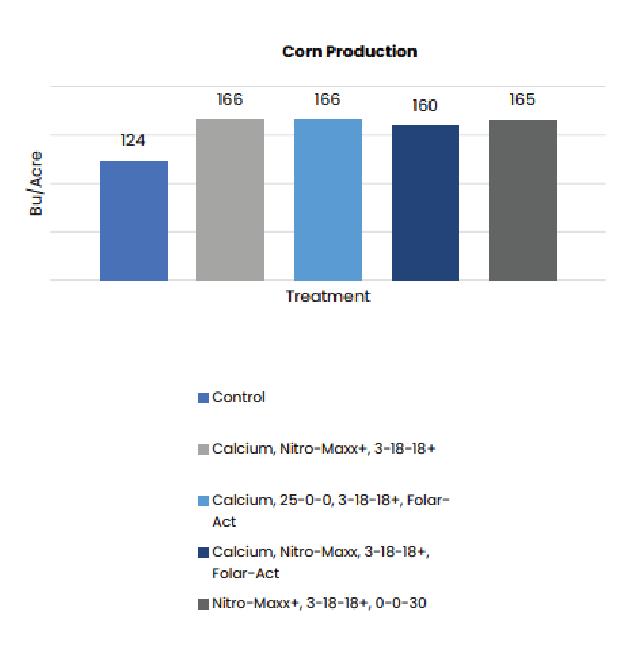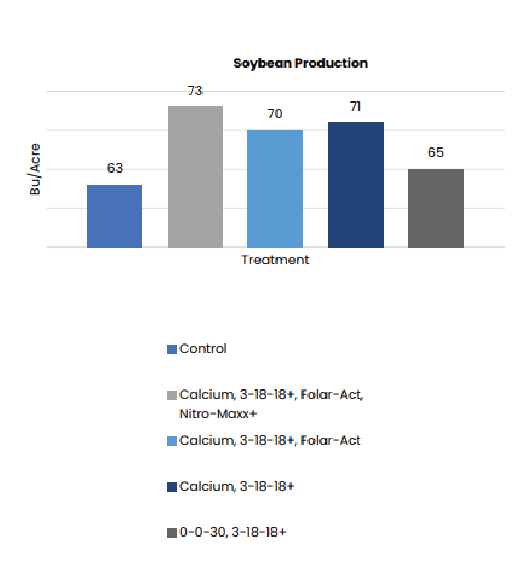Corn & Bean
Which Fertilizers Should You Be Using?
10-20-10+
AgriTec's 10-20-10+ is part of our orthophosphate fertilizer program. Orthophosphate fertilizers are the fastest and most efficient way to provide nutrients to the soil and to the plant. This form of liquid fertilizer supplies the nutrients to the soil immediately with no breakdown time or risks of loss like standard fertilizers.
3-18-18+
3-18-18+ is a liquid solution with the best source of potash and phosphorus that is immediately available to the soil. No need to wait for rain or for breakdown times, 3-18-18+ can be easily applied during many stages of growth to ensure crops are getting the phosphorus and potassium they need for the best possible growth.
25-0-0
Information coming soon.
Bio-Act
Bio-Act® is a a nutritional plant supplement that can be used as a soil treatment, seed start, or foliar feed. Bio-Act® contains a blend of micro-nutrients and minerals that provide a unique source of nutrition to the plant and to the soil. This blend of micro-nutrients also contains humic acid which provides valuable nutrition for the plant and adds feed value to the crop.
Nitro-Maxx+
Nitro-Maxx+ is the next generation of nitrogen application. Nitrogen is such a crucial nutrient for ensuring strong healthy growth. However, the hassle and risk involved in application has seemed inevitable. With Nitro-Maxx+ those major risks and issues are taken away with our slow-release liquid nitrogen. Designed to release over time while decreasing burn and dissipation.
How does liquid calcium affect corn & beans?
One of the biggest factors that impacts plant productivity is having nutrient-rich soil. Soil with lots of hydrogen will naturally be more acidic. Acidic soil prevents nutrients from going into the plant and thereby decreases plant productivity.
To combat this, liquid calcium actually displaces, or moves, the hydrogen out of the way, allowing more nutrients to enter the plant. As the hydrogen is getting displaced, it causes the pH of the soil to increase, making it less acidic. As pH increases, so does plant productivity.
How does ag-lime compare to liquid calcium?
Ag-lime has a pH neutralizing (carbonate material) effect on soil after 6 to 8 months from application, but does not immediately correct soil calcium deficiency. In contrast, liquid calcium goes to work in one hour.
Liquid calcium is mined from the ground in the same way that limestone is extracted and pulverized. But unlike limestone, the process doesn’t stop there. The crude material goes through a process of heating, liquifying, and then extracting the pure soluble liquid calcium, doing away with all the sediment that would normally end up in your soil, and chelating the calcium to make it ready for agriculture use. The raw calcium is then mixed with carrying agents, surfactants, and chloride to make the ease of application and delivery simple and very effective. Chloride in this small amount is proven to increase photosynthesis in the plant creating faster and stronger growth, and also increasing drought resistance and disease resistance and suppressant. Please note, chloride in this form is not the same as the crude chloride used on roads and in tractor tires. Just as some forms of lime are used for hardening soil before construction, or to be mixed with concrete, there is a distinct difference and importance in understanding ag grade products meant for agriculture purposes, and crude material used for construction or in tires.
University backing of liquid calcium
AgriTec has land grant university research from multiple universities, showing how calcium changes soil pH, and just how crucial and important calcium is to the soil and to the plant. AgriTec continues to conduct studies and build further evidence that calcium is more effective than dry lime and raising soil pH and improving soil conditions.
"Liquid calcium chloride, an often-overlooked nutrient, is essential for plant growth. Deficiencies of this nutrient have been verified in Kansas. Chloride is essential for photosynthesis and serves other critical roles in plants. Plants take up chloride as the Cl- ion. This ion is very mobile in the soil and is subject to leaching. Soil testing and plant analyses have proven useful in identifying potential deficiencies of chloride. Recent Kansas research has verified a need for chloride fertilization on some soils."
Ray E. Lamond Extension Agronomy Specialist Soil Fertility and Soil Management; Dale F. Leikam Extension Agronomy Specialist Nutrient Management
"Unfortunately, the role of calcium in plant nutrition is often eclipsed by interest in macronutrients or specific micronutrients. Many are overlooked and only considered when deficiency disorders influence the economic threshold of produce quality and value. However, we know that calcium 1) is a multifunctional nutrient in the physiology of crop plants and 2) in the soluble form influences availability and uptake. Nitrogen-use efficiency of urea-containing fertilizers is also increased with soluble calcium sources such as calcium nitrate."
Dr. G. W. Easterwood Calcium's Role in Plant Nutrition
"We apply fertilizer nutrient materials to the above ground growing portion of the plant. We have seen that materials are absorbed by the plant and move rather freely in the plant. The amounts may at first seem relatively small, but to offset this handicap, the efficiency is high. In fact, this is the most efficient method of applying fertilizer to plants that we have yet discovered. If we apply these materials to the leaves in soluble forms, as much as 95% of what is applied may be used by the plant. If we apply a similar amount to the soil, we find about 10% of it to be used."
Dr. H. B. Tukey Head of Department of Horticulture at Michigan State University
Agricenter Testing Facility
Objective: Evaluate the impact that AgriTec International’s general corn production recommendations have on soil profile characteristics.
Overview: Control plot received 200 units of N, 50 units of P, and 100 units of K. There were 4 testing plots that received variations of AgriTec fertilizer programs.
Corn Production Results:
Control – 200 units N, 50 units P, 100 units K:
124 bu/acre
Plot 1 – Calcium, Nitro-Maxx+, 3-18-18+:
166 bu/acre
Plot 2 – Calcium, 25-0-0, 3-18-18+, Folar-Act:
166 bu/acre
Plot 3 – Calcium, Nitro-Maxx+, 3-18-18+, Folar-Act:
160 bu/acre
Plot 4 – Nitro-Maxx+, 3-18-18+, 0-0-30:
165 bu/acre

Agricenter Testing Facility
Objective: Evaluate the impact that AgriTec International’s general soybean production recommendations have on soil profile characteristics.
Overview: Control plot received 30 units of P and 90 units of K. There were 4 testing plots that received variations of AgriTec’s fertilizer programs.
Soybean Production Results:
Control – 30 Units P, 90 units K:
63 bu/acre
Plot 1 – Calcium, 3-18-18+, Folar-Act, Nitro-Maxx+:
73 bu/acre
Plot 2 – Calcium, 3-18-18+, Folar-Act:
70 bu/acre
Plot 3 – Calcium, 3-18-18+
71 bu/acre
Plot 4 – 0-0-30, 3-18-18+:
65 bu/acre

Testimonials
Playlist
Have any questions, concerns, or would like to place an order?
We’re always here to help! Call us at 833-247-4832, send us an email at info@agritecint.com, or fill out the form below!









